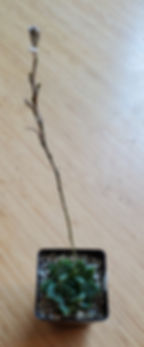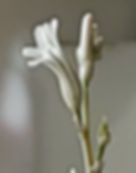Hand pollination of Haworthia
- Chris
- Sep 13, 2020
- 3 min read
Updated: Sep 27, 2020
I have recently had some success with Haworthia pollination, so I thought I would share what I have learned. I also thought of some new ideas that most other similar instructions miss out.
Crossing and making hybrid of different Haworthia species can be fun and surprising! Hybrids can assume some very interesting forms! Keep in mind, that for whatever reason, some crosses just don't work, so don't get frustrated, and just try as many combinations as possible. It is also a good idea to take notes of positions, sex, date, and what was pollinated with what.
Tools: The only thing you really need is a good pair of forceps. They need to be fine/small enough to deal with the small size of the flower petal and stamens. The most delicate part of the flower should be considered the pistol and the stigma, which should never be touched directly with anything besides donor anthers. I prefer smooth biology style forceps, that don't have ridged grips. The ridged grips can damage the delicate stamens making them harder to handle. Before your use it, soak in 70% isopropyl for at least a minute, and then all it to evaporate fully before using. Do this periodically during a long pollination session. This will avoid any possible transfer of diseases that may exist.



Plants: To pollinate Haworthia, your first need at least two flowering Haworthias! They shoot out these long inflorescences (as shown to the right), and usually open up a new flower every day or two. The flowers are actually rather boring and dull, compared to most other succulents (lower right image).
Basics of plant sex: Haworthia's cannot self pollinate. So you need a donor male flower for pollen, and a female recipient. Each flower has both male and female parts. Flowers can be used for pollen (as a male) on the first day of opening, but I have found it better to wait for the second day, when the anthers are more mature. A flower (as the female) is ready to receive pollen on the 3rd day after opening. Refer to the labeled image below.
First, the petals must be carefully removed using forceps and your finger, or two forceps. You have to tug it to pull it off the flower. Try to grab from the base so you can get the whole petal the first time. be sure not to damage the ovary, particularly the pistol and stigma.


Remove a mature anther (as identified in the labeled image above) by plucking the stamen (using some fine, smooth forceps) from a 1-2 day old flower, and use it to pollinate a 2-4 day old female stigma of another plant. Rub the anther on the stigma and up and down the pistol. You should be able to just barely see some pollen be transferred, but sometimes its hard to see. Having some sort of magnification lens can be useful here. I found that it helped to physically gently mash mature anther so that the pollen can be released and transferred effectively. I place it on a clean sheet of paper, and press down on the anther with the dull end on a clean knife.
This process can be repeated another one or two times over consecutive days, but wait 24hrs between attempts to be sure you are not knocking off previously deposited pollen. During that 24hrs, the pollen will be absorbed by the stigma, travel down the pistol, and find the ovary which contains the eggs for pollination.


Below: A successful pollination of Haworthia cymbiformis. The ovary has remained, and is obviously larger, ~8-10 days after pollination. The non-pollinated ovaries atrophy and disappear.

Coming up:
Protecting pollinated ovary's.
Seed collection
Storing pollen?
to be continued...
